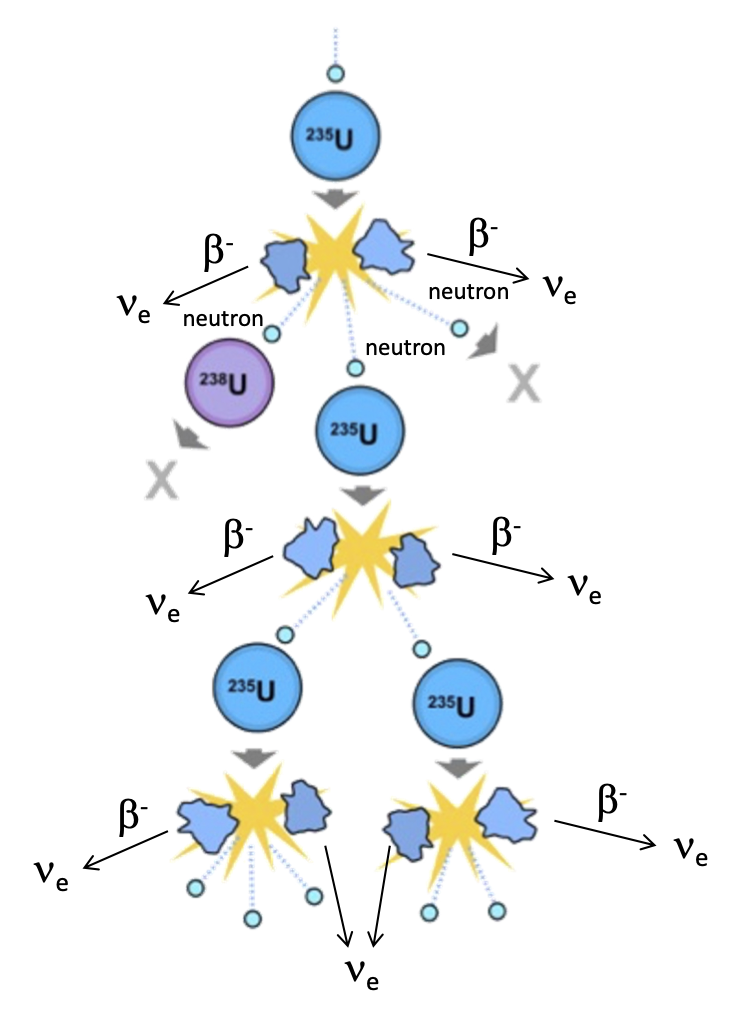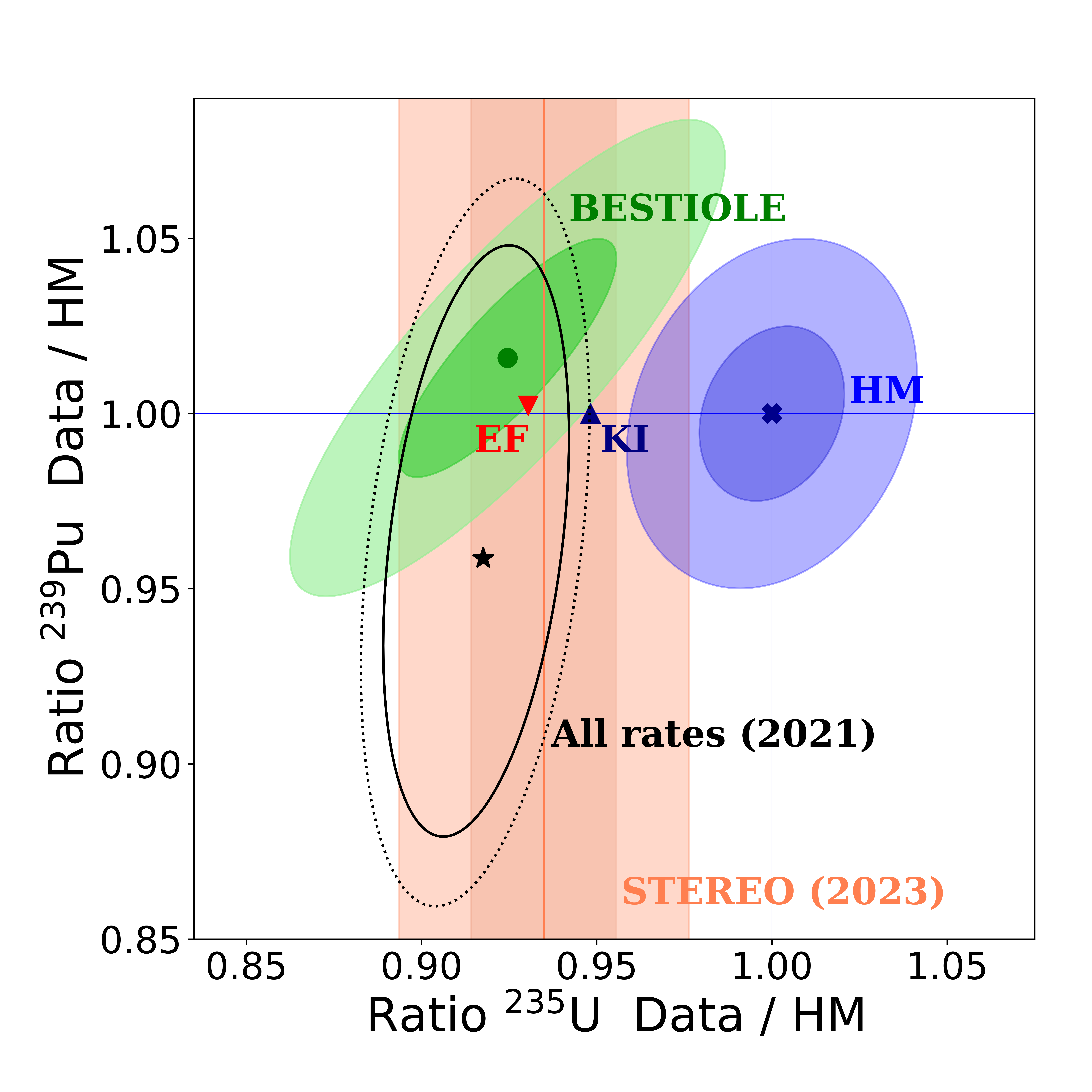
Figure 1: Sketch of a uranium-235 fission chain reaction in a nuclear reactor core. Antineutrinos are emitted by β- decay of the fission products (credit; Wikimedia Commons)
Supported by CEA's "digital simulation" cross-disciplinary program, Irfu, the Laboratoire National Henri Becquerel of DRT and the Service d'Étude des Réacteurs et de Mathématiques Appliquées of DES teamed up to carry out a thorough review of calculations of antineutrino spectra from nuclear reactors. A complete revision of the summation method lays a new and solid foundations for these calculations, and was featured as the Physical Review C journal editor’s suggestion [1] on November 27, 2023. This revision incorporates numerous improvements in the beta decay modeling of the thousands of branches making up a reactor antineutrino spectrum, and in the use of nuclear evaluated data. It also quantifies all the systematic effects known to influence the calculations, providing for the first time a complete uncertainty model. This major advance now makes the summation model, long criticized for being approximate and incomplete, a robust tool for predicting reactor antineutrino spectra and for interpreting current and future experimental measurements. This work will likely stimulate targeted research to check and improve the experimental inputs, with potentially wide-ranging impact, from weak-interaction physics to many aspects of nuclear reactor science and technology. It also sheds interesting light on the origin of reactor antineutrino anomalies [2,3].
Reactor antineutrinos are mostly emitted from the β- decay of the fission products of uranium 235 and 238 and plutonium 239 and 241 in nuclear fuel (see figure 1). Since their first detection in 1956, they are widely used for probing neutrino fundamental properties, and more recently for searching for signs of new physics beyond the Standard Model. Determining the spectra of antineutrinos emitted by a reactor, which are essential for interpreting measurements, remains an arduous task, which still motivates huge experimental and theoretical efforts. Some first attempts were conducted to quantify the neutrino interaction cross-section from measurements and date back to the late 1950s. At this time, computational resources were much more limited than they are today, and the required input nuclear data were unreliable and very incomplete. Predictions then relied on a clever procedure using virtual beta branches to convert an electron spectrum, measured following irradiation of a uranium-235 foil by a thermal neutron flux, into an antineutrino spectrum [4]. This method, known as the conversion method, has since been extensively tested and refined, notably thanks to a remarkable series of high-precision measurements of electron spectra obtained in the 1980s at the high-flux reactor of the Institut Laue Langevin (ILL, Grenoble).
The more natural and direct summation method models and sums the beta spectra of all known fission products to predict the expected total spectrum (see figure 2). The first realistic calculations were published in the early 1970s, especially with the advent of the first evaluated nuclear databases [5]. However, the reliability of these calculations is severly questioned by a number of challenges, the main one being that the nuclear data are incomplete and often poorly known, since they are based on measurements that are often inconsistent. A blatant example of this major flaw, now well known to the nuclear data evaluation community, is the “pandemonium effect”, which biases the determination of decay patterns of excited nuclei by measuring their gamma cascades [6]. For these reasons, antineutrino spectra have long been predicted using the conversion method. Until very recently, the Huber-Mueller (HM) conversion model, based on electron measurements at ILL, was the reference in the community.

Figure 2 : Antineutrino spectrum resulting from the thermal fission of uranium 235. The total spectrum (in black) is broken down into some 800 individual spectra (in grey) representing the contributions of all the fission fragments known to date. Interestingly, only a handful of fission products contribute significantly to the total flux. Shown here in red are the fission products that contribute more than 1% to the total antineutrino flux detected by inverse beta decay.. (credit: arXiv:2304.14992 [nucl-ex])
The reactor antineutrino anomaly (RAA), highlighted in 2011 following a revision of the conversion procedure [7], has yet to find a clear explanation. The many experimental programs carried out over the past decade, including the STEREO experiment piloted by Irfu and the KATRIN experiment, have all produced negative results in their search for a 4th sterile neutrino. The RAA has also been supplemented by discordant measurements. These include disagreements between the energy spectra of antineutrinos measured by inverse beta decay (IBD) and those predicted by the conversion method in the 4 to 7 MeV region [3], as well as a new assessment of the 235U/239Pu ratio of electron spectra measured following thermal neutron irradiation of uranium-235 and plutonium-239 foils [8], which contradicts the ILL reference measurements!
Supported by the CEA's "digital simulation" cross-disciplinary program, Irfu, the Laboratoire National Henri Becquerel of DRT and the Service d'Étude des Réacteurs et de Mathématiques Appliquées of DES have teamed up to deeply review the calculation of reactor antineutrino spectra using the summation method. Firstly, a new formalism for calculating beta spectra has been incorporated into the BESTIOLE code developed in 2010 at Irfu [9] to include the most important electromagnetic and atomic corrections. The treatment of forbidden transitions, long considered to another weak point of the summation method because the shape of their spectrum remains poorly known, has also been greatly improved. For the first time, a much more realistic calculation of these transitions has been carried out by determining the structure of the involved nuclear states using a shell model with an effective interaction, and precisely coupling it to the beta decay model. The second major area of improvement was the updating of all the nuclear data used for these calculations, incorporating all the measurements carried out over the past decade to correct the most important fission products for the pandemonium effect. Throughout this work, a careful study of all systematic effects, whether arising from beta branch modeling or from the use of the nuclear evaluated data, was carried out in order to construct a complete and realistic uncertainty budget for the very first time. This study has highlighted the remaining weaknesses of the summation model, enabling future experimental and theoretical efforts to be directed towards improving its robustness and accuracy. It appears, for example, that a ~25% portion of the antineutrino flux emitted by a reactor is still inaccurately modeled, especially because of the incompleteness of the nuclear databases and the pandemonium effect. This finding confirms the results of a previous study published by our teams.
All these developments have improved the predictive power of the summation model, while protecting it from possible calculation biases. Uncertainties of the order of one percent around 2 MeV to ten percent above 8 MeV have been obtained on the calculation of an antineutrino spectrum, making this new model competitive with conversion predictions. This new version of the summation model was then compared with the latest experimental measurements and state-of-the-art theoretical predictions. Figure 3 compares IBD measurements and predictions of antineutrino fluxes emitted by fission of uranium 235 and plutonium 239, expressed relatively to the reference HM prediction (in blue). Remarkably, the new summation model (in green) agrees very well with the latest result from STEREO (orange band), which has provided the most accurate measurement of antineutrino flux from uranium-235 fission to date. Interestingly, the new summation model shifts the IBD flux from uranium-235 fission by -(7.5 ± 3.9)% compared with the HM model. This shift would significantly reduce the statistical significance of the RAA. It also supports other suspicions that poor normalization of the uranium-235 electron data measured at ILL is at the root of the prediction bias in the HM reference model. Other comparative studies have been carried out, showing good agreement in rate and shape with the most accurate IBD measurements conducted at reactors (Daya Bay, STEREO, PROSPECT, etc.). These studies demonstrate the added value of this new model for analyzing and interpreting all available experimental data in a coherent manner, in order to shed light on the origin of reactor antineutrino anomalies. This last point is essential, particularly in view of future experimental programs involving measurements on reactors, whether using inverse beta decay or coherent elastic neutrino scattering on nuclei.

Figure 3 : comparison of IBD antineutrino fluxes from uranium-235 and plutonium-239 fission predicted by the new summation model (in green), with state-of-the art predictions (HM and KI conversion models, EF summation model) and experimental measurements (STEREO in orange and a combination of other reactor measurements in black). IBD fluxes are expressed relative to those predicted by the reference HM model. (credit: arXiv:2304.14992 [nucl-ex])
Matthieu Vivier (DRF/IRFU/DPhP)
(DRT/LIST/LNHB)
Alain Letourneau (DRF/IRFU/DPhN)
[1] L. Périssé, A. Onillon, X. Mougeot, M. Vivier et al., Phys. Rev. C 108, 055501 (2023)
[2] G. Mention, M. Fechner, T. Lasserre, T. A. Mueller et al., Phys. Rev. D 83, 073006 (2011)
[3] H. de Kerret et al. (Double Chooz collaboration) Nat. Phys 16, 558 (2019)
[4] C. O. Muehlhause and S. Oleksa, Phys. Rev. 105, 1332 (1957)
[5] F. T. Avignone III, Phys. Rev. D 2, 2609 (1970)
[6] J. Hardy, L. Carraz, B. Jonson and P. Hansen, Phys. Lett. B 71, 307 (1977)
[7] T. A. Mueller, D. Lhuillier, M. Fallot, A. Letourneau et al., Phys. Rev. C 83, 054615 (2011)
[8] V. Kopeikin, M. Skorokhvatov and O. Titov, Phys. Rev. D 104, L071301 (2021)
[9] L. Périssé, thèse de doctorat de l’université Paris-Saclay (2021) https://tel.archives-ouvertes.fr/tel-03538198
• The ultimate constituents of matter › Neutrino Physics Modelisation, calculation and data analysis
• Institute of Research into the Fundamental Laws of the Universe • The Nuclear Physics Division • The Particle Physics Division
• LENA group - Structure of the Atomic Nuclei • Sources and reactors neutrinos
